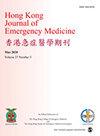肺炎入院频率与院内心脏骤停发生率之间的关系:一项基于人群的病例对照研究
IF 0.8
4区 医学
Q4 EMERGENCY MEDICINE
引用次数: 0
摘要
目的:探讨肺炎住院频率与住院心脏骤停发生率之间的关系。方法:我们使用1996年至2011年的纵向索赔子数据集,对1739名住院心脏骤停患者和6956名随机选择的年龄和性别匹配的对照患者进行了研究 从台湾国民健康保险计划覆盖的人口中随机选择的万人。计算了住院心脏骤停与肺炎住院人数的比值比。结果:在15年的研究期间,住院心脏骤停组的发生率较高(28.4%vs 8.1%,p < 0.0001)。住院心脏骤停组的心力衰竭、慢性肺病、糖尿病、肾衰竭、肝病、淋巴瘤、酗酒和药物滥用的合并症高于对照组。此外,因肺炎入院的患者发生院内心脏骤停的风险为3.37,而因肺炎多次入院的患者出现院内心脏停搏的风险增加(一次3.03;两次3.44;三次4.42)。在交叉分析中,因肺炎住院的患者越多,合并症的数量就越多,住院心脏骤停的风险越高(比值比 = 21.37,95%置信区间 = 13.6–33.9,对于因肺炎入院三次以上且合并症三次以上的患者)。结论:较高的肺炎住院频率与较高的住院心脏骤停风险相关。意识到这一风险因素可能有助于临床医生在入院后立即为有潜在住院心脏骤停风险的患者提供早期预防或检测。本文章由计算机程序翻译,如有差异,请以英文原文为准。
Association between the frequency of admission for pneumonia and the incidence of in-hospital cardiac arrest: A population-based case–control study
Objective: To examine the association between the frequency of admission for pneumonia and the incidence of in-hospital cardiac arrest. Methods: We enrolled 1739 patients with in-hospital cardiac arrest and 6956 randomly selected age- and sex-matched control patients using a longitudinal claims sub-dataset from 1996 to 2011 for 1 million people randomly selected from the population covered by the Taiwan National Health Insurance program. The odds ratio of in-hospital cardiac arrest associated with the number of hospital admissions for pneumonia was calculated. Results: During the 15-year study period, the in-hospital cardiac arrest group had a higher frequency (28.4% vs 8.1%, p < 0.0001) of admission for pneumonia compared to the control group. The comorbidities of heart failure, chronic pulmonary disease, diabetes, renal failure, liver disease, lymphoma, alcohol abuse, and drug abuse were higher in the in-hospital cardiac arrest group than in the control group. In addition, the risk of in-hospital cardiac arrest was 3.37 for the patients admitted for pneumonia, and the risk of in-hospital cardiac arrest increased for patients with multiple admissions for pneumonia (once, 3.03; two times, 3.44; and three times, 4.42). In cross-analysis, the more admissions for pneumonia and the greater the number of comorbidities, the higher the risk of in-hospital cardiac arrest (odds ratio = 21.37, 95% confidence interval = 13.6–33.9 for patients with more than three admissions for pneumonia and more than three comorbidities). Conclusion: Higher admission frequency for pneumonia was associated with a higher risk of in-hospital cardiac arrest. Awareness of this risk factor may help clinicians provide early prevention or detection for patients with potential in-hospital cardiac arrest risks immediately after admission.
求助全文
通过发布文献求助,成功后即可免费获取论文全文。
去求助
来源期刊

Hong Kong Journal of Emergency Medicine
EMERGENCY MEDICINE-
CiteScore
1.50
自引率
16.70%
发文量
26
审稿时长
6-12 weeks
期刊介绍:
The Hong Kong Journal of Emergency Medicine is a peer-reviewed, open access journal which focusses on all aspects of clinical practice and emergency medicine research in the hospital and pre-hospital setting.
 求助内容:
求助内容: 应助结果提醒方式:
应助结果提醒方式:


